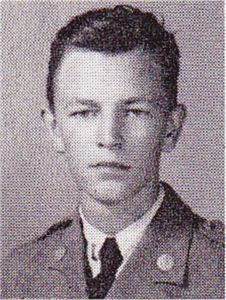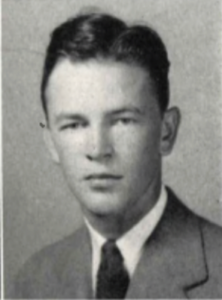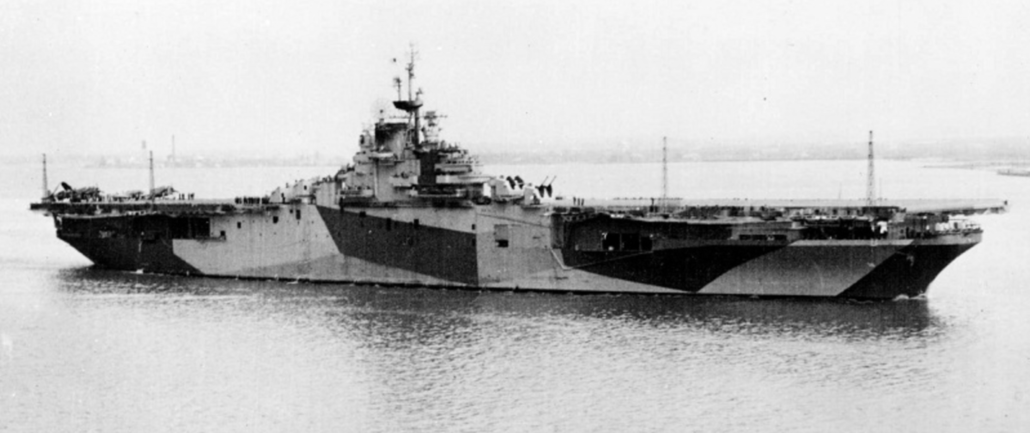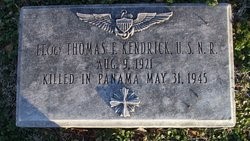Scroll of Honor – Henry Randolph Peebles
Carrier Pilot
Written by: Kelly Durham

When we think of the Navy’s role in World War II, we typically envision Pacific Ocean carrier battles like Coral Sea, Midway and the Philippine Sea. But Thomas Franklin Kendrick of Laurens, Class of 1942, participated in the Navy’s little remembered carrier operations in the Mediterranean Sea in August 1944.
Kendrick, an English major, attended Clemson as a freshman during the 1938-1939 academic year before transferring to Georgia Tech. At Tech, Kendrick switched his major to industrial management. He was a member of the Industrial Management Society, the golf team, and Sigma Alpha Epsilon. Following the Japanese attack on Pearl Harbor, Kendrick volunteered for military service and upon graduation, he reported for duty with the Navy.
Kendrick earned his pilot’s wings and was assigned to a fighter squadron aboard the USS Kasaan Bay, one of the Navy’s smaller escort or “jeep” carriers. These baby flattops had been developed in part to provide aerial support for trans-Atlantic convoys in an ultimately successful effort to counter the German’s U-boat threat.
In January 1944, Kasaan Bay was tasked with ferrying new aircraft and personnel to Pearl Harbor. Following this mission, she  returned to Norfolk, Virginia for overhaul and then embarked on a voyage to Casablanca in North Africa on another ferry mission. Following her return to the States, Kasaan Bay again headed east, this time bound for Oran for anti-submarine warfare operations in the western Mediterranean before practicing for the Allied invasion of southern France. Kasaan Bay arrived on station for the invasion on August 15, 1944. Kasaan Bay’s aircraft flew missions in support of the Allied landings.
returned to Norfolk, Virginia for overhaul and then embarked on a voyage to Casablanca in North Africa on another ferry mission. Following her return to the States, Kasaan Bay again headed east, this time bound for Oran for anti-submarine warfare operations in the western Mediterranean before practicing for the Allied invasion of southern France. Kasaan Bay arrived on station for the invasion on August 15, 1944. Kasaan Bay’s aircraft flew missions in support of the Allied landings.
On August 25, Lieutenant (jg) Kendrick flew a mission near Montpellier, west of Marseille. Dipping below a 600-foot cloud ceiling, Kendrick’s flight discovered an enemy convoy and began a strafing run. Kendrick fired on a string of four ammunition wagons, descending to just fifty feet above the ground. One of the wagons exploded, throwing debris into the air and damaging Kendrick’s aircraft. On subsequent strafing runs, Kendrick felt that the aircraft was not responding crisply and radioed one of his squadron mates to close on his airplane for a visual inspection. Lieutenant Thomas, the flight leader, observed extensive damage to Kendrick’s starboard stabilizer, the small tail wing on the right side of the aircraft. Thomas ordered Kendrick to return to the ship. After an uneventful landing, inspection of the damage revealed that Kendrick’s control cables had been nearly severed. For his “heroism and extraordinary achievement while participating in aerial flights as pilot of a carrier-based naval fighter bomber during the Allied invasion of Southern France in August 1944,” Kendrick was awarded the Distinguished Flying Cross. But Kendrick’s war was not yet over.
Following Kasaan Bay’s return to the States in September, Kendrick’s squadron was decommissioned and he was assigned to the recently organized fighter-bomber squadron VBF-89 aboard the new USS Antietam, an Essex class fleet carrier. From mid-1943 until the end of the war, Essex class carriers (such as the Yorktown now at Patriot’s Point in Charleston) formed the heart of the Navy’s combat power in the Pacific. Antietam was commissioned in January 1945 and completed her shakedown cruise at the end of April. Post cruise repairs were completed on May 19 and Antietam sailed from Philadelphia that same day, bound for the Pacific via the Panama Canal.

Flight operations aboard Antietam continued while the ship was in transit. On May 31, as the carrier approached Cristobal, on the Caribbean side of the Canal, Kendrick was killed in the crash of his F-4U Corsair while on a training flight.
Kendrick was survived by his wife, the former Frieda Dekker of Boston, Massachusetts, his parents, and his sister. Following the war, Kendrick’s remains were returned to Laurens where he was buried in the city cemetery. 
For more information about Lieutenant (jg) Thomas Franklin Kendrick see:
https://soh.alumni.clemson.edu/scroll/thomas-franklin-kendrick/
For additional information about Clemson University’s Scroll of Honor visit:
https://soh.alumni.clemson.edu/
